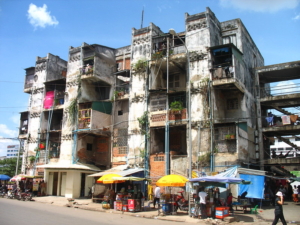Living Conditions in Cambodia’s Slums
 Cambodia has made remarkable strides in rebuilding its economy since the Khmer Rouge regime ended. However, amid this progress, the issue of urban poverty and slums, characterized by a highly concentrated urban area consisting of densely packed, dilapidated housing units, persists. Communities in Cambodia’s slums often suffer from impoverishment, overcrowding and unsanitary conditions. Residents in these slums endure dire living situations and poor infrastructure with limited access to resources and support.
Cambodia has made remarkable strides in rebuilding its economy since the Khmer Rouge regime ended. However, amid this progress, the issue of urban poverty and slums, characterized by a highly concentrated urban area consisting of densely packed, dilapidated housing units, persists. Communities in Cambodia’s slums often suffer from impoverishment, overcrowding and unsanitary conditions. Residents in these slums endure dire living situations and poor infrastructure with limited access to resources and support.
Populations Living in Slums
Data from the World Bank indicates a drastic decline in the population living in Cambodia’s slums, decreasing from 85% of the urban population in 2000 to 40% in 2020. Unfortunately, urban poverty and slums continue to pose significant economic and social challenges for the country.
Living Conditions in Slums
The Taramana Magdalena Center, an organization supporting marginalized communities in major Cambodian cities, describes Phnom Penh’s slums as “overcrowded, non-isolated and flood-prone”, which increases the risk of spreading diseases and bacterial growth. Families in slums often encounter land insecurity, unsafe housing, limited access to clean water and sanitation and high unemployment. Unfortunately, impoverished living conditions can lead to detrimental problems, such as water-related diseases, alcohol, drug and gambling addiction and domestic violence.
Typically, Cambodia’s slums experience poor sanitation & hygiene as well as high rates of diarrhea and malnutrition. Lack of toilets, proper drainage, garbage disposal system and overcrowded dwellings are common problems exacerbating health issues in vulnerable communities.
Drug Epidemic
The severity of substance abuse in urban slums prompted the Cambodian government to launch a major drug crackdown. A 2023 article by the Khmer Times, “Cambodia’s slums, a haven for drug abuse,” highlights the increasingly rampant drug use and sales in slum dwellings, mostly populated by homeless people and beggars.
Children’s Health and Education
As of today, The Taramana Magdalena Center determines that, due to the lack of access to vaccination and medical care, 37% of children under 5 in Cambodia face chronic malnutrition, which may reach 70% in some vulnerable areas, including slums.
A 2018 UNICEF Cambodia study, “Child Protection and Education Needs for the Children and Adolescents of Phnom Penh’s Urban Poor Communities,” found that children and adolescents living in urban poor communities face multiple risks and deprivations due to urban poverty. Parents or caregivers often prioritize earning income and have limited time to care for their children adequately. Their lack of knowledge about proper childcare also contributes to the family’s diminished capacity to protect children from risks, provide education, ensure proper nutrition and access essential services.
Solutions and Initiatives
Since 1996, U.N.-Habitat has actively supported Cambodia’s national and provincial governments, city authorities and communities to improve living standards. The organization provides technical assistance in Cambodia, covering water and sanitation, affordable housing, disaster risk reduction, slum upgrading, poverty reduction and urban planning.
Habitat for Humanity Cambodia collaborates with various organizations and authorities to provide safe and affordable housing, water and sanitation interventions and welfare support. Their approach includes reducing disaster risk, influencing housing policies and regulations and promoting financial stability among populations living in Cambodia’s slums.
On the other hand, Planète Enfants & Développement (PE&D) focuses on family dynamics and social issues. The organization provides social workers to help communities in Phnom Penh’s slums address domestic violence, gender equality and parenting. Families are also taught about budgeting and financial management to tackle financial issues related to addiction and gambling. Moreover, savings and microcredit groups are established in each neighborhood, enabling residents to finance immediate needs and small housing projects.
A Look Ahead
Multilateral and community organizations continue to empower communities and improve living conditions for vulnerable urban populations in Cambodia’s slums. Through collaborative efforts, these organizations provide technical assistance, safe housing, water and sanitation interventions, address social issues and promote financial stability. These efforts aim to create positive and sustainable changes in the lives of those living in Cambodia’s slums.
– Freya Ngo
Photo: Flickr
